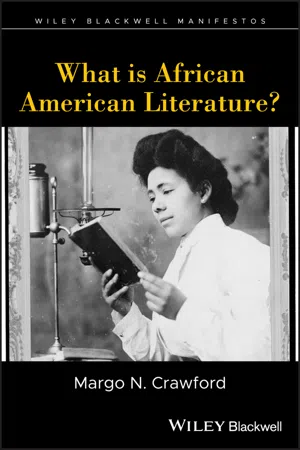
- English
- ePUB (mobile friendly)
- Available on iOS & Android
What is African American Literature?
About this book
After Kenneth W. Warren's What Was African American Literature?, Margo N. Crawford delivers What is African American Literature?
The idea of African American literature may be much more than literature written by authors who identify as "Black". What is African American Literature? focuses on feeling as form in order to show that African American literature is an archive of feelings, a tradition of the tension between uncontainable black affect and rigid historical structure. Margo N. Crawford argues that textual production of affect (such as blush, vibration, shiver, twitch, and wink) reveals that African American literature keeps reimagining a black collective nervous system.
Crawford foregrounds the "idea" of African American literature and uncovers the "black feeling world" co-created by writers and readers. Rejecting the notion that there are no formal lines separating African American literature and a broader American literary tradition, Crawford contends that the distinguishing feature of African American literature is a "moodscape" that is as stable as electricity. Presenting a fresh perspective on the affective atmosphere of African American literature, this compelling text frames central questions around the "idea" of African American literature, shows the limits of historicism in explaining the mood of African American literature and addresses textual production in the creation of the African American literary tradition.
Part of the acclaimed Wiley Blackwell Manifestos series, What is African American Literature? is a significant addition to scholarship in the field. Professors and students of American literature, African American literature, and Black Studies will find this book an invaluable source of fresh perspectives and new insights on America's black literary tradition.
Frequently asked questions
- Essential is ideal for learners and professionals who enjoy exploring a wide range of subjects. Access the Essential Library with 800,000+ trusted titles and best-sellers across business, personal growth, and the humanities. Includes unlimited reading time and Standard Read Aloud voice.
- Complete: Perfect for advanced learners and researchers needing full, unrestricted access. Unlock 1.4M+ books across hundreds of subjects, including academic and specialized titles. The Complete Plan also includes advanced features like Premium Read Aloud and Research Assistant.
Please note we cannot support devices running on iOS 13 and Android 7 or earlier. Learn more about using the app.
Information
1
The Textual Production of Black Affect : The Blush of Toni Morrison’s Last Novel
The most successful fiction of most Negro writing is in its emotional content.Amiri Baraka, “The Myth of a ‘Negro Literature’”
For within living structures defined by profit, by linear power,by institutional dehumanization, our feelings were not meantto survive.Audre Lorde, “Poetry is not a Luxury”
The idea was always to make that time emotionallyreal to people.–Octavia Butler1
What was uppermost in my mind while I read her manuscript was that no novel about any black woman could ever be the same after this … So deeply impressed was I that I hadn’t time to be offended by the fact that she was twenty‐four and had no “right” to know so much so well… Even now, almost two years later, I shake my head when I think of her, and the same smile of disbelief I could not hide when I met her, I feel on my mouth still as I write these lines…2
If you got hiv, say aids. If you a girl,/say you’re pregnant––nobody gonna lower/themselves to listen for the kick. People/passing fast. Splay your legs, cock a knee/funny. It’s the littlest shames they’re likely/to comprehend. Don’t say homeless, they know/you is. What they don’t know is what opens/a wallet, what stops em from counting/what they drop. If you’re young say younger./Old say older. If you’re crippled don’t/flaunt it. Let em think they’re good enough/Christians to notice. Don’t say you pray,/say you sin. It’s about who they believe/they is. You hardly even there.4
I was seldom whipped by my old master, and suffered little from any thing else than hunger and cold. I suffered much from hunger, but much more from cold. In hottest summer and coldest winter, I was kept almost naked–no shoes, no stockings, no jacket, no trousers, nothing on but a coarse tow linen shirt, reaching only to my knees. I had no bed. I must have perished with cold, but that, the coldest nights, I used to steal a bag which was used for carrying corn to the mill. I would crawl into this bag, and there sleep on the cold, damp, clay floor, with my head in and feet out. My feet have been so cracked with the frost, that the pen with which I am writing might be laid in the gashes.5
Table of contents
- Cover
- Table of Contents
- Title Page
- Copyright Page
- Acknowledgments
- Introduction: The Affective Atmosphere of African American Literature
- 1 The Textual Production of Black Affect
- 2 Mood Books
- 3 The Vibrations of African American Literature
- 4 Shiver: The Diasporic Shock of Elsewhere
- 5 Twitch or Wink: TheLiterary Afterlife of the Afterlife of Slavery
- CODA
- Index
- End User License Agreement